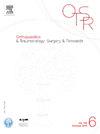The Patient Acceptable Symptom State (PASS) after proximal and distal femoral replacement
IF 2.3
3区 医学
Q2 ORTHOPEDICS
引用次数: 0
Abstract
Introduction
Femoral megaprostheses are used for bone reconstruction surgery in patients with local tumors or who require multiple revisions. Patient reported outcome measures (PROMs) provide a subjective result and, like patient satisfaction, have become an integral part of the outcomes in orthopedics. However, the threshold of satisfaction (PASS: Patient Acceptable Symptom State) has not yet been defined in a French population after this type of arthroplasty. This led us to carry out a retrospective study on a population of patients who received a femoral reconstruction megaprosthesis in order to 1) define the PASS for the Harris Hip Score (HHS), Knee Society Score (KSS) and the Musculoskeletal Tumor Society score (MSTS), 2) study the complications.
Hypothesis
The PASS threshold for proximal femur and distal femur reconstruction prothesis for the HHS and the KSS, respectively, will be lower than the threshold for these same scores for primary arthroplasty.
Materials and methods
Forty-four patients who were operated on between 2009 and 2020 were included: 23 received a proximal femur prosthesis and 21 received a distal femur prosthesis. The PASS threshold was defined using an anchoring strategy by analyzing ROC curves for the HSS for the proximal femur, KSS for the distal femur and the MSTS for all the prostheses. Complications were classified according to Henderson.
Results
The mean follow-up was 4.5 ± 3.6 (1–12.5) years. The PASS threshold was 47.5 (area under curve (AUC) 0.71 (0.45–0.97)) for the HHS, 69.5 (AUC 0.97 (0.92–1.0)) for the KSS knee and 62.5 (AUC 0.81 (0.61–0.99)) for the KSS function. Thirteen patients (29%) had complications, nine of whom required another surgery (20%). The most frequent were Henderson type 1 (soft tissue lesions, n = 5/44 [11%]) and type 2 (loosening, n = 5/44 [11%]) There was no relationship between satisfaction and postoperative complications (p = 0.071).
Discussion
Most of the patients who undergo femoral resection and reconstruction (59%) are satisfied with their function, albeit reduced, despite a high complication rate (29%). Our hypothesis is confirmed for the PASS threshold for the HHS (47.5 versus 93) and the KSS knee and function (69.5 and 62.5 versus 85.5 and 72.5).
Level of evidence
IV; retrospective observational single-center study.
股骨近端和远端置换术后患者可接受症状状态(PASS)。
导言:股骨巨型假体用于局部肿瘤患者或需要多次翻修的患者的骨重建手术。患者报告结果测量(PROMs)提供的是一种主观结果,与患者满意度一样,已成为骨科结果的一个组成部分。然而,在法国人群中,此类关节置换术后的满意度阈值(PASS:患者可接受的症状状态)尚未确定。因此,我们对接受股骨重建巨型假体的患者进行了一项回顾性研究,目的是:1)确定哈里斯髋关节评分(HHS)、膝关节协会评分(KSS)和肌肉骨骼肿瘤协会评分(MSTS)的PASS;2)研究并发症:假设:股骨近端和股骨远端重建假体的HHS和KSS的PASS阈值将分别低于初次关节成形术的相同评分阈值:纳入2009年至2020年间接受手术的44名患者:23名患者接受了股骨近端假体,21名患者接受了股骨远端假体。通过分析股骨近端假体的HSS、股骨远端假体的KSS和所有假体的MSTS的ROC曲线,采用锚定策略确定了PASS阈值。并发症根据亨德森分类:平均随访时间为 4.5 ± 3.6 (1-12.5) 年。HHS的PASS阈值为47.5(曲线下面积(AUC)为0.71(0.45-0.97)),KSS膝关节的PASS阈值为69.5(AUC为0.97(0.92-1.0)),KSS功能的PASS阈值为62.5(AUC为0.81(0.61-0.99))。13名患者(29%)出现并发症,其中9人需要再次手术(20%)。最常见的并发症是亨德森1型(软组织病变,n = 5/44 [11%])和2型(松动,n = 5/44 [11%]),满意度与术后并发症之间没有关系(p = 0.071):讨论:尽管并发症发生率较高(29%),但大多数接受股骨切除和重建术的患者(59%)对其功能表示满意,尽管功能有所减退。我们的假设在HHS的PASS阈值(47.5对93)以及KSS膝关节和功能(69.5和62.5对85.5和72.5)方面得到了证实:证据级别:IV;单中心回顾性观察研究。
本文章由计算机程序翻译,如有差异,请以英文原文为准。
求助全文
约1分钟内获得全文
求助全文
来源期刊
CiteScore
5.10
自引率
26.10%
发文量
329
审稿时长
12.5 weeks
期刊介绍:
Orthopaedics & Traumatology: Surgery & Research (OTSR) publishes original scientific work in English related to all domains of orthopaedics. Original articles, Reviews, Technical notes and Concise follow-up of a former OTSR study are published in English in electronic form only and indexed in the main international databases.

 求助内容:
求助内容: 应助结果提醒方式:
应助结果提醒方式:


